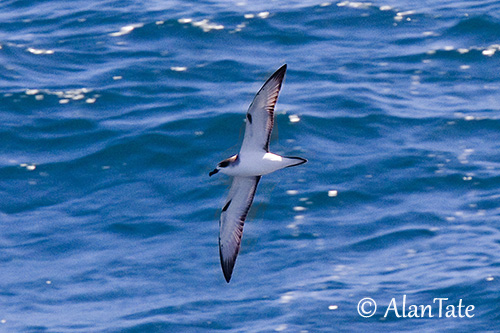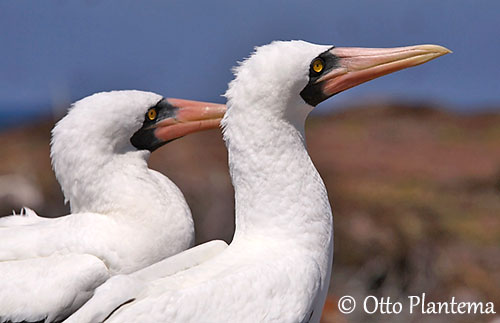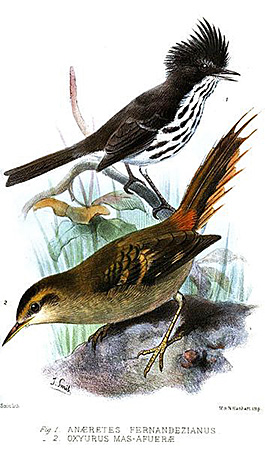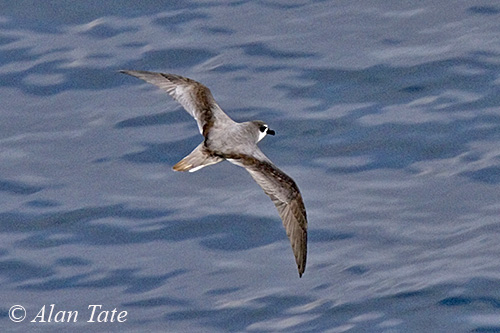

Text by Nicole Bouglouan
Photographers:
John Anderson
John Anderson Photo Galleries
Otto Plantema
Trips around the world
Alan & Ann Tate
AA Bird Photography
Illustrations:
John Gould: 1804-1881
Source: From Gould's 'A Monograph of the Trochilidae or Family of Hummingbirds', Supplement (1880-87) Hart after Gould.
Joseph Smit : 1836-1929
Source: https://archive.org/details/ibis13brit/page/180/mode/2up?view=theater
Sources of the text:
Birdlife International – Data Zone
Endemic breeding birds of Juan Fernández archipelago, Chile
Hummingbirds of the Juan Fernández Islands: natural history, evolution and population status
La « myrtisylve » de l'archipel Juan Fernández (Chili), une foręt en voie de disparition rapide
Juan Fernández Islands Temperate Forests
HA3, JUAN FERNANDEZ ISLANDS, CHILE
JUAN FERNÁNDEZ ISLANDS RESTORATION PROJECT
Juan Fernández Archipelago National Park
Conservation of the Juan Fernandez firecrown and its island habitat
Wikipedia, the free encyclopaedia
Bird species list: Avibase (Lepage Denis)
Endemic species:
Juan Fernández Firecrown - Sephanoides fernandensis - Colibri robinson
Juan Fernández Tit-Tyrant - Anairetes fernandezianus - Taurillon de Juan Fernández
Masafuera Rayadito - Aphrastura masafuerae - Synallaxe de Masafuera
Endemic nesters:
Juan Fernandez Petrel - Pterodroma externa - Pétrel de Juan Fernandez
Stejneger's Petrel - Pterodroma longirostris - Pétrel de Stejneger
Other Bird species:
American Golden Plover – Pluvialis dominica – Pluvier bronzé
American Kestrel – Falco sparverius – Crécerelle d’Amérique
Antarctic Prion - Pachyptila desolata - Prion de la Désolation
Arctic Tern - Sterna paradisaea – Sterne arctique
Austral Blackbird - Curaeus curaeus - Carouge austral
Austral Thrush - Turdus falcklandii - Merle austral
Black-browed Albatross - Thalassarche melanophris - Albatros à sourcils noirs
Blackish Oystercatcher – Haematopus ater - Huitrier noir
Black-necked Swan - Cygnus melanocoryphus - Cygne à cou noir
Buller’s Albatross - Thalassarche bulleri - Albatros de Buller
Buller's Shearwater - Ardenna bulleri - Puffin de Buller
California Quail - Callipepla californica - Colin de Californie
Cape Petrel - Daption capense - Damier du Cap
Chatham Island Albatross - Thalassarche eremita - Albatros des Chatham
Chilean Skua - Stercorarius chilensis - Labbe du Chili
Cocoi Heron - Ardea cocoi - Héron cocoi
Common Redstart - Phoenicurus phoenicurus - Rougequeue à front blanc
Coscoroba Swan – Coscoroba coscoroba - Coscoroba blanc
Dark-faced Ground-Tyrant - Muscisaxicola maclovianus - Dormilon bistré
Flesh-footed Shearwater - Ardenna carneipes - Puffin à pieds pâles
Gentoo Penguin - Pygoscelis papua - Manchot papou
Green-backed Firecrown - Sephanoides sephaniodes - Colibri du Chili
Grey-flanked Cinclodes - Cinclodes oustaleti - Cinclode d’Oustalet
Grey Noddy - Anous albivitta - Noddi gris
Grey Petrel - Procellaria cinerea - Puffin gris
Grey Plover - Pluvialis squatarola - Pluvier argenté
Guanay Cormorant - Leucocarbo bougainvillii - Cormoran de Bougainville
House Sparrow - Passer domesticus - Moineau domestique
Humboldt Penguin - Spheniscus humboldti - Manchot de Humboldt
Juan Fernandez Petrel - Pterodroma externa - Pétrel de Juan Fernandez
Kelp Gull - Larus dominicanus – Goéland dominicain
Kermadec Petrel - Pterodroma neglecta - Pétrel des Kermadec
Long-tailed Jaeger - Stercorarius longicaudus - Labbe à longue queue
Magellanic Penguin - Spheniscus magellanicus - Manchot de Magellan
Manx Shearwater - Puffinus puffinus - Puffin des Anglais
Masatierra Petrel – Pterodroma defilippiana – Pétrel de Filippi
Masked Booby - Sula dactylatra - Fou masqué
Northern Giant-Petrel – Macronectes halli – Pétrel de Hall
Peregrine Falcon - Falco peregrinus - Faucon pèlerin
Peruvian Pelican - Pelecanus thagus - Pélican thage
Phoenix Petrel - Pterodroma alba - Pétrel à poitrine blanche
Pink-footed Shearwater - Ardenna creatopus - Puffin à pieds roses
Pomarine Skua or Jaeger - Stercorarius pomarinus - Labbe pomarin
Providence Petrel - Pterodroma solandri - Pétrel de Solander
Red-billed Tropicbird – Phaethon aethereus – Phaéton à bec rouge
Red-fronted Coot - Fulica rufifrons - Foulque à front rouge
Red-gartered Coot - Fulica armillata - Foulque à jarretières
Red Phalarope - Phalaropus fulicarius - Phalarope à bec large
Red-tailed Tropicbird - Phaethon rubricauda - Phaéton à brins rouges
Rock Dove or Rock Pigeon - Columba livia - Pigeon biset
Rufous-collared Sparrow – Zonotrichia capensis - Bruant chingolo
Salvin's Albatross - Thalassarche salvini - Albatros de Salvin
Sanderling – Calidris alba - Bécasseau sanderling
Short-eared Owl - Asio flammeus - Hibou des marais
Slender-billed Prion or Thin-billed Prion - Pachyptila belcheri - Prion de Belcher
Sooty Shearwater - Ardenna grisea - Puffin fuligineux
Sooty Tern - Onychoprion fuscatus - Sterne fuligineuse
Southern Fulmar - Fulmarus glacialoides - Fulmar argenté
Southern Giant Petrel - Macronectes giganteus - Pétrel géant
Southern Lapwing - Vanellus chilensis - Vanneau téro
Southern Royal Albatross - Diomedea epomophora - Albatros royal (du Sud)
Spectacled Duck or Bronze-winged Duck - Speculanas specularis - Canard à lunettes
Spotted Rail – Pardirallus maculates - Râle tacheté
Stejneger's Petrel - Pterodroma longirostris - Pétrel de Stejneger
Swainson’s Thrush - Catharus ustulatus - Grive à dos olive
Swallow-tailed Gull - Creagrus furcatus - Mouette à queue fourchue
Tufted Tit-Tyrant - Anairetes parulus - Taurillon mésange
Turkey Vulture - Cathartes aura - Urubu à tête rouge
Variable Hawk - Geranoaetus polyosoma – Buse tricolore
Wandering Albatross - Diomedea exulans - Albatros hurleur
Western Cattle Egret - Bubulcus ibis - Héron garde-bœufs
Westland Petrel - Procellaria westlandica - Pétrel du Westland
Whimbrel – Numenius phaeopus – Courlis corlieu
White-bellied Storm-Petrel - Fregetta grallaria - Océanite à ventre blanc
White-chinned Petrel - Procellaria aequinoctialis - Puffin à menton blanc
White-faced Storm-Petrel - Pelagodroma marina - Océanite frégate
White-tailed Tropicbird – Phaethon lepturus – Phaéton à bec jaune
White-tufted Grebe - Rollandia rolland - Grèbe de Rolland
Wilson’s Storm-Petrel - Oceanites oceanicus - Océanite de Wilson
JUAN FERNANDEZ ISLANDS BIRD SPECIES
The Juan Fernández Islands are located in the Southern Pacific Ocean, 670 km off Chilean coast. The archipelago is composed of three main islands named Robinson Crusoe Island, Alejandro Selkirk Island and Santa Clara Island, and several smaller ones. These volcanic islands rise steeply out of the Pacific. Few beaches and a small number of protected bays are probably formed by ancient volcanic craters.
The total area is about 181 km². The small population (about 600) resides in San Juan Bautista the capital, on the north coast.
The name comes from the Spanish sailor Juan Fernández, who discovered the archipelago on 22 November 1574 while sailing between Peru and Valparaíso. At this period, the islands were named Más Afuera, Más a Tierra, and Islote de Santa Clara.
The Juan Fernández Islands have a subtropical climate, strongly influenced by fluctuations of the cold subantarctic Humboldt Ocean Current passing powerfully between the islands and the mainland, and the south east trade winds, both creating high-winter and low-summer rainfall pattern and a stable temperature environment (around 15,4°C). Flora and fauna resemble mostly those found in C and S Pacific rather than those of the South American continent.

The islands are covered with both native and introduced species of grasses and weeds on slopes at lower altitudes. The lowland is covered with tall forest where several tree species are found such as Drimys confertifolia and Myrceugenia fernandeziana on Robinson Crusoe Island, and Myrceugenia schulzei, endemic to Alejandro Selkirk Island. The three species are flowering plant in the family Winteraceae and endemic to the ecoregion.
On Robinson Crusoe Island, the largest of the islands with 93km², the endemic flora and fauna are mainly only present near the almost vertical wall at top of El Yunque Mount which is the highest site at 916 metres above sea level.
Alejandro Selkirk Island is 50 km², and the highest peak is Los Inocentes at 1319 metres.
Santa Clara is the smallest with 2,2 km² and 350 metres of elevation.
Many plants are related to plants found in South America, New Zealand and Australia. The vegetated areas include grassland and shrubland at lower elevations, mainly tall and montane forests at middle elevations, and alpine shrubland at the highest points. Endemic tree-fern species (Dicksonia and Thyrsopteris) are predominant in tree-fern forests. The endemic Chonta palm (Juania australis) is endangered.

About the avifauna, two hummingbird species including the endemic, Critically Endangered Juan Fernández Firecrown and the continental Green-backed Firecrown can be found.
The endemic species Juan Fernández Firecrown is now extinct on Alejandro Selkirk Island, whereas the population on Robinson Crusoe Island has greatly declined in recent decades. It depends on the island’s native forests to survive.
On the other hand, the population of the Green-backed Firecrown is suspected to have increased on Robinson Crusoe Island, and it is now established on Alejandro Selkirk Island.

Two endemic breeding species including the Stejneger's Petrel and the Juan Fernandez Petrel are the entire known breeding populations of these species. They are endemic breeders to Alejandro Selkirk Island, and both species are listed as Vulnerable.

Two other species, the Masafuera Rayadito of family Furnariidae (Critically Endangered) on Alejandro Selkirk Island, and the Juan Fernández Tit-Tyrant of family Tyrannidae (Near Threatened) on Robinson Crusoe Island, are living in the archipelago.

The Juan Fernández Islands are very important locations for six breeding seabirds. Among them the Masatierra Petrelor De Filippi's Petrel, and the Pink-footed Shearwater, both classified as Vulnerable.

Two waves of introduced animals by colonists such as goats, rats, cats and dogs in the 1600s and cattle, sheep, rabbits and coatis in the 1800s, involved the decline of both flora and fauna and have increased erosion throughout these islands.
A large part of the native forest has been cleared below 500 metres of elevation, whereas on Robinson Crusoe Island, introduced plant species, especially bramble, provide the only vegetal cover. Today, only 10% of the island is covered with natural vegetation.
These islands are a National Park since 1935, and a designated UNESCO Biosphere Reserve since 1977. The archipelago is one of the most ecologically vulnerable ecosystems in the world.
Conservation programs are underway to remove invasive species from the Juan Fernández Archipelago.
